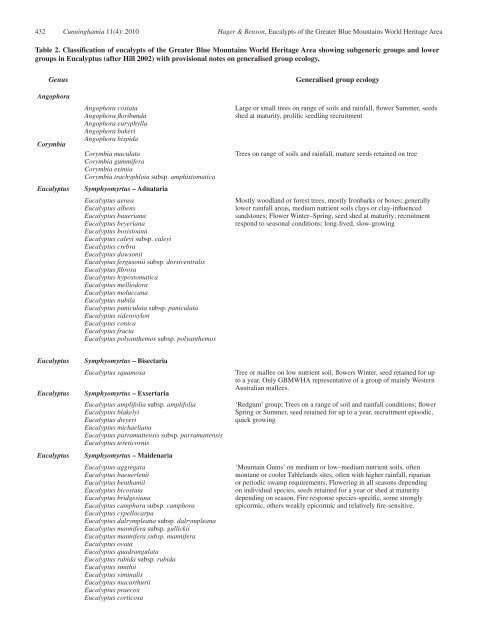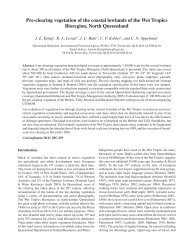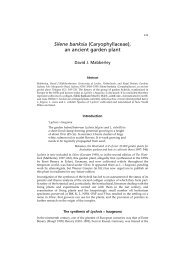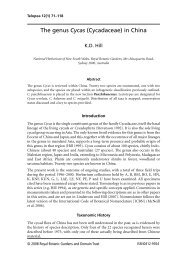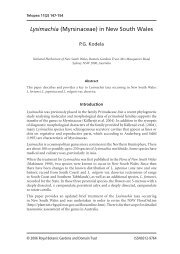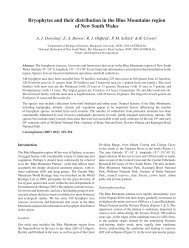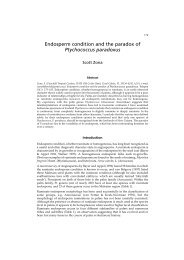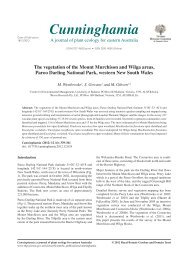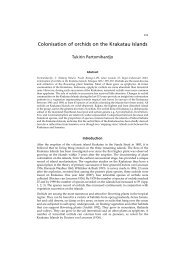The Eucalypts of the Greater Blue Mountains World Heritage Area ...
The Eucalypts of the Greater Blue Mountains World Heritage Area ...
The Eucalypts of the Greater Blue Mountains World Heritage Area ...
Create successful ePaper yourself
Turn your PDF publications into a flip-book with our unique Google optimized e-Paper software.
432 Cunninghamia 11(4): 2010 Hager & Benson, <strong>Eucalypts</strong> <strong>of</strong> <strong>the</strong> <strong>Greater</strong> <strong>Blue</strong> <strong>Mountains</strong> <strong>World</strong> <strong>Heritage</strong> <strong>Area</strong><br />
Table 2. Classification <strong>of</strong> eucalypts <strong>of</strong> <strong>the</strong> <strong>Greater</strong> <strong>Blue</strong> <strong>Mountains</strong> <strong>World</strong> <strong>Heritage</strong> <strong>Area</strong> showing subgeneric groups and lower<br />
groups in Eucalyptus (after Hill 2002) with provisional notes on generalised group ecology.<br />
Genus Generalised group ecology<br />
Angophora<br />
Corymbia<br />
Angophora costata<br />
Angophora floribunda<br />
Angophora euryphylla<br />
Angophora bakeri<br />
Angophora hispida<br />
Corymbia maculata<br />
Corymbia gummifera<br />
Corymbia eximia<br />
Corymbia trachyphloia subsp. amphistomatica<br />
Eucalyptus Symphyomyrtus – Adnataria<br />
Eucalyptus aenea<br />
Eucalyptus albens<br />
Eucalyptus baueriana<br />
Eucalyptus beyeriana<br />
Eucalyptus bosistoana<br />
Eucalyptus caleyi subsp. caleyi<br />
Eucalyptus crebra<br />
Eucalyptus dawsonii<br />
Eucalyptus fergusonii subsp. dorsiventralis<br />
Eucalyptus fibrosa<br />
Eucalyptus hypostomatica<br />
Eucalyptus melliodora<br />
Eucalyptus moluccana<br />
Eucalyptus nubila<br />
Eucalyptus paniculata subsp. paniculata<br />
Eucalyptus sideroxylon<br />
Eucalyptus conica<br />
Eucalyptus fracta<br />
Eucalyptus polyan<strong>the</strong>mos subsp. polyan<strong>the</strong>mos<br />
Large or small trees on range <strong>of</strong> soils and rainfall, flower Summer, seeds<br />
shed at maturity, prolific seedling recruitment<br />
Trees on range <strong>of</strong> soils and rainfall, mature seeds retained on tree<br />
Mostly woodland or forest trees, mostly Ironbarks or boxes; generally<br />
lower rainfall areas, medium nutrient soils clays or clay-influenced<br />
sandstones; Flower Winter–Spring, seed shed at maturity; recruitment<br />
respond to seasonal conditions; long-lived, slow-growing<br />
Eucalyptus Symphyomyrtus – Bisectaria<br />
Eucalyptus squamosa Tree or mallee on low nutrient soil, flowers Winter, seed retained for up<br />
to a year. Only GBMWHA representative <strong>of</strong> a group <strong>of</strong> mainly Western<br />
Eucalyptus Symphyomyrtus – Exsertaria<br />
Australian mallees.<br />
Eucalyptus amplifolia subsp. amplifolia<br />
Eucalyptus blakelyi<br />
Eucalyptus dwyeri<br />
Eucalyptus michaeliana<br />
Eucalyptus parramattensis subsp. parramattensis<br />
Eucalyptus tereticornis<br />
Eucalyptus Symphyomyrtus – Maidenaria<br />
Eucalyptus aggregata<br />
Eucalyptus baeuerlenii<br />
Eucalyptus benthamii<br />
Eucalyptus bicostata<br />
Eucalyptus bridgesiana<br />
Eucalyptus camphora subsp. camphora<br />
Eucalyptus cypellocarpa<br />
Eucalyptus dalrympleana subsp. dalrympleana<br />
Eucalyptus mannifera subsp. gullickii<br />
Eucalyptus mannifera subsp. mannifera<br />
Eucalyptus ovata<br />
Eucalyptus quadrangulata<br />
Eucalyptus rubida subsp. rubida<br />
Eucalyptus smithii<br />
Eucalyptus viminalis<br />
Eucalyptus macarthurii<br />
Eucalyptus praecox<br />
Eucalyptus corticosa<br />
‘Redgum’ group; Trees on a range <strong>of</strong> soil and rainfall conditions; flower<br />
Spring or Summer, seed retained for up to a year, recruitment episodic,<br />
quick growing<br />
‘Mountain Gums’ on medium or low–medium nutrient soils, <strong>of</strong>ten<br />
montane or cooler Tablelands sites, <strong>of</strong>ten with higher rainfall, riparian<br />
or periodic swamp requirements; Flowering in all seasons depending<br />
on individual species, seeds retained for a year or shed at maturity<br />
depending on season. Fire response species-specific, some strongly<br />
epicormic, o<strong>the</strong>rs weakly epicormic and relatively fire-sensitive.


